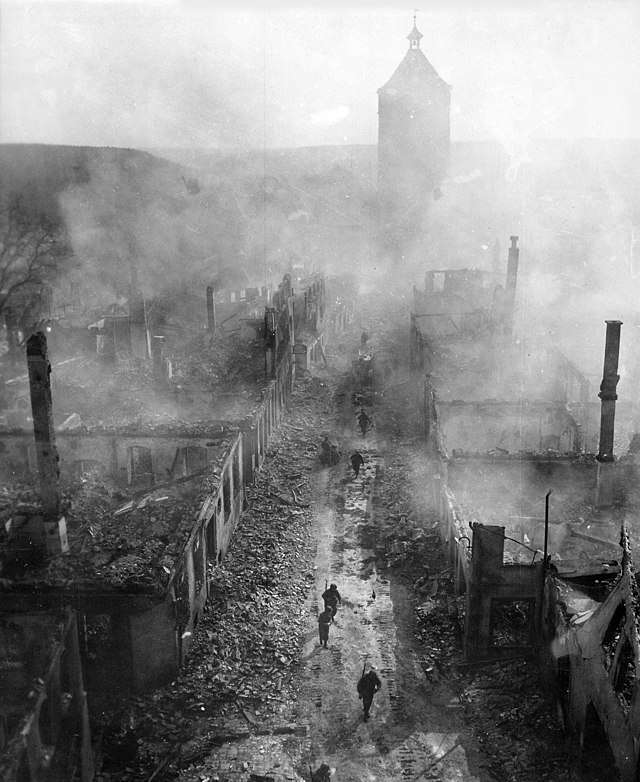1940-åra
tiår From Wikipedia, the free encyclopedia
Remove ads
1940-åra var eit tiår på 1900-talet. Det var sterkt prega av andre verdskrigen, som herja i bortimot heile verda i fyrste halvdelen av tiåret. Krigen hadde store menneskelege og politiske verknadar, og førte med seg opprettingar av fleire nye land og internasjonale organisasjonar. Det blei også innført nye sosiale system, som statleg velferd og det økonomiske Bretton Woods-systemet. Ny teknologi og vitskap utvikla under krigen blei vidareutvikla i etterkrigstida, som ballistiske missil, kjernekraft, datamaskinar, radar og jetmotorar.

Remove ads
Hendingar i utlandet
Krigar

- Andre verdskrigen
- Nazi-Tyskland invaderte Polen, Danmark, Noreg, Benelux og Frankrike frå 1939 til 1941.
- Sovjetunionen invaderte Polen og Finland og okkuperte Latvia, Estland, Litauen og dden rumenske regionen Bessarabia frå 1939 til 1941.
- USA gjekk inn i krigen etter det japanske åtaket på Pearl Harbor 7. desember 1941.
- Holocaust, også kjend som sjoah, viser vanlegvis til folkemordet på rundt seks millionar europeiske jødar i løpet av andre verdskrigen i eit målretta program drive av Nazi-Tyskland, allierte og kollaboratørar.[1] Nokre forskarar meiner at Holocaust-omgrepet også bør omfatta dei systematiske drapa på millionar av andre grupper, som etniske polakkar, romfolk, sovjetiske krigsfangar og sivile, folk med funksjonshemmingar, homofile og politiske og religiøse motstandarar.[2] Etter denne definisjonen er talet på Holocaust-offer mellom 11 og 17 millionar menneske.[3]
- Manhattanprojektet; utviklinga av den fyrste atombomba og bruken av slike våpen over Hiroshima og Nagasaki
- Nürnbergprosessane blei gjennomførte etter krigen.
- Andre
- Den greske borgarkrigen frå 1946 til 1949
- Borgarkrigen i Palestinamandatet frå 1947 til 1948
- Krigen mellom India og Pakistan i 1947–1948
- Den arabisk-israelske krigen i 1948
- Den kalde krigen byrja med Berlin-blokaden i 1948-1949
Internasjonale organisasjonar
- 1945 – Opprettinga av Dei sameinte nasjonane (SN)
- 1949 – Opprettinga av NATO og Europarådet
Sjølvstende og nye land
- 1944 – Island erklærte sjølvstende frå Danmark.
- 1945 – Indonesia erklærte sjølvstende frå Nederland, og oppnådde sjølvstende i 1949 etter ein bitter militær og diplomatisk strid.
- 1945 – Korea blei frigjort etter at Japan overgav seg
- 1946 – Det franske mandatet for Syria og Libanon blei oppløyst til dei sjølvstendige statane Syria og Libanon.
- 1947 – Delinga av Britisk India førte til eit sjølvstendig, sekulært India og eit hovudsakleg muslimsk Pakistan.
- 1948 – Det britiske styret i Burma tok slutt.
- 1948 – Staten Israel blei etablert.
- 1949 – Folkerepublikken Kina blei offisielt erklært.
- 1949 – Forbundsrepublikken Tyskland og Den tyske demokratiske pepublikken blei begge grunnlagde i 1949.
Remove ads
Hendingar i Noreg
- Operasjon Weserübung, den tyske invasjonen av Noreg i april 1940
- Tvangsevakueringa og nedbrenninga av Finnmark og Nord-Troms frå 1944 til 1945
- Barnetrygd blei innført i Noreg i 1946
Viktige personar
Statsleiarar
Militærleiarar
 Feltmarskalk Erwin Rommel
Feltmarskalk Erwin Rommel Reichsmarschall Hermann Göring
Reichsmarschall Hermann Göring Feltmarskalk Erich von Manstein
Feltmarskalk Erich von Manstein Feltmarskalk Gerd von Rundstedt
Feltmarskalk Gerd von Rundstedt Marskalk Ion Antonescu
Marskalk Ion Antonescu General Hideki Tōjō
General Hideki Tōjō General Kuniaki Koiso
General Kuniaki Koiso Feltmarskalk Hajime Sugiyama
Feltmarskalk Hajime Sugiyama Flåteadmiral Isoroku Yamamoto
Flåteadmiral Isoroku Yamamoto Flåteadmiral Osami Nagano
Flåteadmiral Osami Nagano Feltmarskalk Georgij Zjukov
Feltmarskalk Georgij Zjukov Feltmarskalk Ivan Konev
Feltmarskalk Ivan Konev General Dwight D. Eisenhower
General Dwight D. Eisenhower General George Marshall
General George Marshall General Douglas MacArthur
General Douglas MacArthur General Omar Bradley
General Omar Bradley General George S. Patton
General George S. Patton Flåteadmiral Chester W. Nimitz
Flåteadmiral Chester W. Nimitz Flåteadmiral Ernest J. King
Flåteadmiral Ernest J. King Feltmarskalk Harold Alexander
Feltmarskalk Harold Alexander Feltmarskalk Bernard Montgomery
Feltmarskalk Bernard Montgomery Général d'Armée Jean de Lattre de Tassigny
Général d'Armée Jean de Lattre de Tassigny Brigadergeneral Charles de Gaulle
Brigadergeneral Charles de Gaulle General Henri Winkelman
General Henri Winkelman General Bernhard av Lippe-Biesterfeld
General Bernhard av Lippe-Biesterfeld
Aktivistar og religiøse leiarar
- Joel Brand
- Behic Erkin
- Varian Fry
- Mohandas Gandhi
- Billy Graham
- Yitzhak HaLevi Herzog
- Muhammad Ali Jinnah
- Necdet Kent
- Aristides de Sousa Mendes
- Pave Pius XII
- Martha Sharp
- Waitstill Sharp
- Chiune Sugihara
- Raoul Wallenberg
Kjelder
Wikiwand - on
Seamless Wikipedia browsing. On steroids.
Remove ads
